| Nymphaea | |
|---|---|

| |
| Nymphaea alba L., the type species of the genus | |
| Scientific classification | |
| Kingdom: | Plantae |
| Clade: | Tracheophytes |
| Clade: | Angiosperms |
| Order: | Nymphaeales |
| Family: | Nymphaeaceae |
| Genus: | Nymphaea L. |
| Type species | |
| Nymphaea alba L. | |
| Species | |
|
65 species, see text | |
| Synonyms | |
| |
Nymphaea (/nɪmˈfiːə/) is a genus of hardy and tender aquatic plants in the family Nymphaeaceae. The genus has a cosmopolitan distribution. Many species are cultivated as ornamental plants, and many cultivars have been bred. Some taxa occur as introduced species where they are not native, and some are weeds. Plants of the genus are known commonly as water lilies, or waterlilies in the United Kingdom. The genus name is from the Greek νυμφαία, nymphaia and the Latin nymphaea, which means "water lily" and were inspired by the nymphs of Greek and Latin mythology.
Description

- E1: upper epiderm
- E2: lower epiderm
- P: palisade mesophyll
- M: spongy mesophyll
- B: vascular bundle
- I: intercellular gap
- S: sclerenchyma


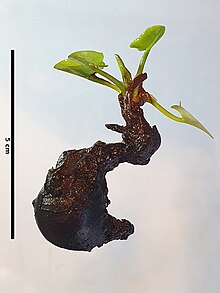


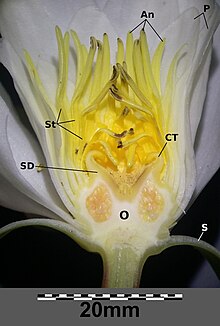
S = sepals, P = petals, St = stamina, An = anthers, O = ovary, SD = stigma disc, CT = carpellary teeth


Upper surface (left) and lower surface (right)
Vegetative characteristics
Water lilies are aquatic, rhizomatous or tuberous, perennial or annual herbs with sometimes desiccation-tolerant, branched or unbranched rhizomes, which can be stoloniferous, or lacking stolons. The tuberous or fibrous roots are contractile. The leaves are mostly floating, but submerged and emergent leaves occur as well. The shape of the lamina can be ovate, orbicular, elliptic, hastate, or sagittate. The width of the lamina ranges in size from 2.5–3 cm to 40–60 cm. The lamina has a deep sinus and the basal lobes can be overlapping or divergent. The margin of the lamina can be entire, dentate, or sinuate. The leaves can be stipulate, or exstipulate. The petioles are a few centimetres to 5–6 m long, and 0.3–1.9 cm wide.
Generative characteristics
The flowers are emergent, floating, or rarely submerged. The diurnal or nocturnal, chasmogamous or rarely cleistogamous, solitary, hermaphrodite, entomophilous, fragrant or inodorous flowers are mostly protogynous. The flowers have (3–)4(–5) green, sometimes spotted sepals, and about 6–50 lanceolate to spathulate, differently coloured petals, which are often gradually transitioning into the shape of the stamens. The gap between petals and stamens can be present or absent. The androecium consists of 20–750 stamens. The stamens can be petaloid or not petal-like. The gynoecium consists of 5–35 carpels. The carpels usually posess a sterile appendage. The globose, fleshy, spongy, irregularly dehiscent fruit, borne on a terete, glabrous or pubescent, curved or coiled peduncle, bears arillate, globose to elliptic, hairy or glabrous seeds with a smooth surface or longitudinal ridges. Proliferating pseudanthia or tuberous flowers (i.e., sterile, branching, proliferating floral structures for vegetative propagation) can be present or absent.
Cytology
Various ploidy levels have been observed in Nymphaea: 2x, 3x, 4x, 6x, 8x, and 16x. The chromosome count ranges from 28 to 224.
Taxonomy
The genus Nymphaea L. was described by Carl Linnaeus in 1753. It has three synonyms: Castalia Salisb. published by Richard Anthony Salisbury in 1805, Leuconymphaea Kuntze published by Otto Kuntze in 1891, and Ondinea Hartog published by Cornelis den Hartog in 1970. The type species is Nymphaea alba L.
Subgenera
The genus Nymphaea has been divided into several subgenera:
- Nymphaea subg. Anecphya (Casp.) Conard
- Nymphaea subg. Brachyceras (Casp.) Conard
- Nymphaea subg. Confluentes S.W.L.Jacobs
- Nymphaea subg. Hydrocallis (Planch.) Conard
- Nymphaea subg. Lotos (DC.) Conard
- Nymphaea subg. Nymphaea (autonym)
Sections
The subgenus Nymphaea subg. Nymphaea has been divided into sections:
- Nymphaea sect. Chamaenymphaea (Planch.) Wiersema
- Nymphaea sect. Nymphaea (autonym)
- Nymphaea sect. Xanthantha (Casp.) Wiersema
Species
As of January 2024, there are 65 accepted species by Plants of the World Online:
- Nymphaea abhayana A.Chowdhury & M.Chowdhury
- Nymphaea alba L.
- Nymphaea alexii S.W.L.Jacobs & Hellq.
- Nymphaea amazonum Mart. & Zucc.
- Nymphaea ampla (Salisb.) DC.
- Nymphaea atrans S.W.L.Jacobs
- Nymphaea belophylla Trickett
- Nymphaea × borealis E.G.Camus
- Nymphaea caatingae C.T.Lima & Giul.
- Nymphaea candida C.Presl
- Nymphaea carpentariae S.W.L.Jacobs & Hellq.
- Nymphaea conardii Wiersema
- Nymphaea × daubenyana W.T.Baxter ex Daubeny
- Nymphaea dimorpha I.M.Turner
- Nymphaea divaricata Hutch.
- Nymphaea elegans Hook.
- Nymphaea elleniae S.W.L.Jacobs
- Nymphaea francae C.T.Lima & Giul.
- Nymphaea gardneriana Planch.
- Nymphaea georginae S.W.L.Jacobs & Hellq.
- Nymphaea gigantea Hook.
- Nymphaea glandulifera Rodschied
- Nymphaea gracilis Zucc.
- Nymphaea guineensis Schumach. & Thonn.
- Nymphaea harleyi C.T.Lima & Giul.
- Nymphaea hastifolia Domin
- Nymphaea heudelotii Planch.
- Nymphaea immutabilis S.W.L.Jacobs
- Nymphaea jacobsii Hellq.
- Nymphaea jamesoniana Planch.
- Nymphaea kakaduensis Hellq., A.Leu & M.L.Moody
- Nymphaea kimberleyensis (S.W.L.Jacobs) S.W.L.Jacobs & Hellq.
- Nymphaea lasiophylla Mart. & Zucc.
- Nymphaea leibergii (Morong) Rydb.
- Nymphaea lingulata Wiersema
- Nymphaea loriana Wiersema, Hellq. & Borsch
- Nymphaea lotus L.
- Nymphaea lukei S.W.L.Jacobs & Hellq.
- Nymphaea macrosperma Merr. & L.M.Perry
- Nymphaea maculata Schumach. & Thonn.
- Nymphaea manipurensis Asharani & Biseshwori
- Nymphaea mexicana Zucc.
- Nymphaea micrantha Guill. & Perr.
- Nymphaea noelae S.W.L.Jacobs & Hellq.
- Nymphaea nouchali Burm.f.
- Nymphaea novogranatensis Wiersema
- Nymphaea odorata Aiton
- Nymphaea ondinea Löhne, Wiersema & Borsch
- Nymphaea oxypetala Planch.
- Nymphaea paganuccii C.T.Lima & Giul.
- Nymphaea pedersenii (Wiersema) C.T.Lima & Giul.
- Nymphaea potamophila Wiersema
- Nymphaea prolifera Wiersema
- Nymphaea pubescens Willd.
- Nymphaea pulchella DC.
- Nymphaea rapinii C.T.Lima & Giul.
- Nymphaea rubra Roxb. ex Andrews
- Nymphaea rudgeana G.Mey.
- Nymphaea siamensis Puripany.
- Nymphaea stuhlmannii (Engl.) Schweinf. & Gilg
- Nymphaea sulphurea Gilg
- Nymphaea × sundvikii Hiitonen
- Nymphaea tenuinervia Casp.
- Nymphaea tetragona Georgi
- Nymphaea thermarum Eb.Fisch.
- Nymphaea × thiona D.B.Ward
- Nymphaea vanildae C.T.Lima & Giul.
- Nymphaea vaporalis S.W.L.Jacobs & Hellq.
- Nymphaea violacea Lehm.
Fossil species
- †Nymphaea brongniartii (Caspary) Saporta
Evolutionary relationships
The genus Nymphaea may be paraphyletic in its current circumscription, as the genera Euryale and Victoria have been placed within the genus Nymphaea in several studies.
Ecology
Habitat
Nymphaea occurs in freshwater, as well as brackish water habitats.
Pollination
Flowers of Nymphaea subg. Hydrocallis are pollinated by Cyclocephala beetles. Likewise, beetle pollination by Ruteloryctes morio, a member of the same Cyclocephalini tribe, has been reported in Nymphaea subg. Lotos. The subgenera Nymphaea subg. Anecphya and Nymphaea subg. Brachyceras are pollinated by bees and flies. The subgenus Nymphaea subg. Nymphaea is pollinated by bees, flies and beetles.
Herbivory
Many birds feed on seeds and fruits of Nymphaea.
Invasive species
Outside of its natural habitat, Nymphaea mexicana and hybrids thereof have become invasive weeds. It has been proposed to employ the weevil species Bagous longulus as a biocontrol agent against Nymphaea mexicana in South Africa. Invasive horticultural hybrids can pose a threat to Nymphaea species through introgressive hybridisation. The naturalised hybrids can displace native species and mask their disappearance, as it can be difficult to distinguish between species and naturalised hybrids.
Conservation
Several species are in danger of extinction. Nymphaea thermarum is classified as critically endangered (CR), Nymphaea loriana is classified as endangered (EN), Nymphaea stuhlmannii is classified as endangered (EN), and Nymphaea nouchali var. mutandaensis is also classified as endangered (EN).
Use
Horticulture
Water lilies are not only decorative, but also provide useful shade which helps reduce the growth of algae in ponds and lakes. Many of the water lilies familiar in water gardening are hybrids and cultivars. These cultivars have gained the Royal Horticultural Society's Award of Garden Merit:
- 'Escarboucle' (orange-red)
- 'Gladstoniana' (double white flowers with prominent yellow stamens)
- 'Gonnère' (double white scented flowers)
- 'James Brydon;' (cupped rose-red flowers)
- 'Marliacea Chromatella' (pale yellow flowers)
- 'Pygmaea Helvola' (miniature, with cupped fragrant yellow flowers)
Food
| This section needs additional citations for verification. Please help improve this article by adding citations to reliable sources in this section. Unsourced material may be challenged and removed. Find sources: "Nymphaea" – news · newspapers · books · scholar · JSTOR (June 2022) (Learn how and when to remove this message) |
All water lilies are poisonous and contain an alkaloid called nupharin in almost all of their parts.
In India, it has mostly been eaten as a famine food or as a medicinal (both cooked).
In Sri Lanka it was formerly eaten as a type of medicine and its price was too high to serve as a normal meal, but in the 1940s or earlier some villagers began to grow water lilies in the paddy fields left uncultivated during the monsoon season (Yala season), and the price dropped. The tubers are called manel here and eaten boiled and in curries.
In West Africa, usage varied between cultures, in the Upper Guinea the rhizomes were only considered famine foods - here the tubers were either roasted in ashes, or dried and ground into a flour. The Buduma people ate the seeds and rhizomes. Some tribes ate the rhizomes raw. The Hausa people of Ghana, Nigeria and the people of Southern Sudan used the tubers of Nymphaea lotus, the seeds (inside the tubers) are locally referred to as 'gunsi' in Ghana. They are ground into flour.
The plants were also said to be eaten in the Philippines. In the 1950s there were no records of leaves or flowers being eaten.
In a North American species, the boiled young leaves and unopened flower buds are said to be edible. The seeds, high in starch, protein, and oil, may be popped, parched, or ground into flour. Potato-like tubers can be collected from the species N. tuberosa (=N. odorata).
Water lilies were said to have been a major food source for a certain tribe of indigenous Australians in 1930, with the flowers and stems eaten raw, while the "roots and seedpods" were cooked either on an open fire or in a ground oven.
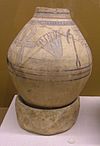
Other uses
Tannins extracted from rhizomes are used in dyeing wool a purple-black or brown colour. The peduncles are used as pipes to smoke tobacco.
Culture



The Ancient Egyptians used the water lilies of the Nile as cultural symbols. Since 1580 it has become popular in the English language to apply the Latin word lotus, originally used to designate a tree, to the water lilies growing in Egypt, and much later the word was used to translate words in Indian texts. The lotus motif is a frequent feature of temple column architecture. In Egypt, the lotus, rising from the bottom mud to unfold its petals to the sun, suggested the glory of the sun's own emergence from the primaeval slime. It was a metaphor of creation. It was a symbol of the fertility gods and goddesses as well as a symbol of the upper Nile as the giver of life.
A Roman belief existed that drinking a liquid of crushed Nymphaea in vinegar for 10 consecutive days turned a boy into a eunuch.
A Syrian terra-cotta plaque from the 14th–13th centuries BC shows the goddess Asherah holding two lotus blossoms. An ivory panel from the 9th-8th centuries BC shows the god Horus seated on a lotus blossom, flanked by two cherubs.
The French Impressionist painter Claude Monet is known for his many paintings of water lilies in the pond in his garden at Giverny.
N. nouchali is the national flower of Bangladesh and Sri Lanka.
Water lilies are also used as ritual narcotics. According to one source, this topic "was the subject of a lecture by William Emboden given at Nash Hall of the Harvard Botanical Museum on the morning of April 6, 1979".
Examples
-
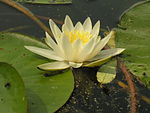 Nymphaea alba
Nymphaea alba
-
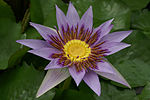 Nymphaea nouchali var. zanzibariensis
Nymphaea nouchali var. zanzibariensis
-
 Nymphaea gigantea
Nymphaea gigantea
-
Nymphaea nouchali
-
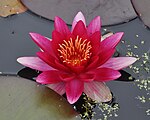 Nymphaea 'Attraction'
Nymphaea 'Attraction'
-
 Nymphaea "Laydekeri Purpurata"
Nymphaea "Laydekeri Purpurata"
-
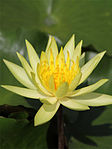 Nymphaea mexicana
Nymphaea mexicana
-
 Nymphaea nouchali var. caerulea
Nymphaea nouchali var. caerulea
-
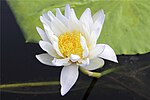 Nymphaea sp.
Nymphaea sp.
-
 Nymphaea × daubenyana
Nymphaea × daubenyana
See also
- Albert de Lestang, propagator and seed collector
- List of plants known as lily
References
- ^ "Nymphaea L." Plants of the World Online. Royal Botanic Gardens, Kew. Retrieved 9 January 2024.
- ^ Nymphaea | International Plant Names Index. (n.d.). Retrieved June 26, 2023, from https://www.ipni.org/n/330032-2
- ^ Nymphaea. Flora of North America.
- ^ Nymphaea. The Jepson eFlora 2013.
- Nymphaea. Integrated Taxonomic Information System (ITIS).
- ^ Western Australian Herbarium & Department of Biodiversity, Conservation and Attractions. (n.d.). Nymphaea L. Florabase—the Western Australian Flora. Retrieved November 26, 2024, from https://florabase.dbca.wa.gov.au/browse/profile/21429
- ^ Heslop-Harrison, Y. (1955). Nymphaea L. Journal of Ecology, 43(2), 719–734. https://doi.org/10.2307/2257032
- ^ Nymphaea Linnaeus. (n.d.). Flora of China @ efloras.org. Retrieved November 26, 2024, from http://www.efloras.org/florataxon.aspx?flora_id=2&taxon_id=122531
- ^ Pellegrini, M.O.O. Nymphaeaceae in Flora e Funga do Brasil. Jardim Botânico do Rio de Janeiro. Disponível em: https://floradobrasil.jbrj.gov.br/FB10936 Acesso em: 27 Nov. 2024
- ^ Royal Botanic Gardens Victoria. (n.d.). Nymphaea. VicFlora Flora of Victoria. Retrieved November 26, 2024, from https://vicflora.rbg.vic.gov.au/flora/taxon/cb56044c-3244-4b72-ad90-e9db471241b2
- ^ Conard, Henry S. (1905). The waterlilies: a monograph of the genus Nymphaea. Pub. by the Carnegie Institution of Washington. https://www.biodiversitylibrary.org/item/108991
- ^ Nymphaea L. (n.d.). Flora of Pakistan @ efloras.org. Retrieved November 26, 2024, from http://www.efloras.org/florataxon.aspx?flora_id=5&taxon_id=122531
- ^ S.W.L. Jacobs & C.L. Porter. Nymphaea, in (ed.), Flora of Australia. Australian Biological Resources Study, Department of Climate Change, Energy, the Environment and Water: Canberra. https://profiles.ala.org.au/opus/foa/profile/Nymphaea
- Robert S. Trickett. (1971). A New Tropical American Waterlily, Nymphaea belophylla. Kew Bulletin, 26(1), 29–31. https://doi.org/10.2307/4117321
- Fischer, E. (1988), Beiträge zur Flora Zentralafrikas. I. Eine neue Nymphaea sowie ein neuer Streptocarpus aus Rwanda. Feddes Repertorium, 99: 385-390.
- Landon, K., Edwards, R. A., & Nozaic, P. I. (2006). A new species of waterlily (Nymphaea minuta: Nymphaeaceae) from Madagascar. SIDA, Contributions to Botany, 887-893.
- ^ Wiersema, J. H. (1988). Reproductive Biology of Nymphaea (Nymphaeaceae). Annals of the Missouri Botanical Garden, 75(3), 795–804. https://doi.org/10.2307/2399367
- Grob, V., Moline, P., Pfeifer, E., Novelo, A. R., & Rutishauser, R. (2006). Developmental morphology of branching flowers in Nymphaea prolifera. Journal of Plant Research, 119, 561-570.
- de Lima, C. T., Machado, I. C., & Giulietti, A. M. (2021). Nymphaeaceae of Brasil. Sitientibus série Ciências Biológicas, 21.
- Wiersema, J. H. (1987). A Monograph of Nymphaea Subgenus Hydrocallis (Nymphaeaceae). Systematic Botany Monographs, 16, 1–112. https://doi.org/10.2307/25027681
- Pellicer, J., Kelly, L. J., Magdalena, C., & Leitch, I. J. (2013). Insights into the dynamics of genome size and chromosome evolution in the early diverging angiosperm lineage Nymphaeales (water lilies). Genome, 56(8), 437-449.
- "Nymphaea subgen. Anecphya | International Plant Names Index". www.ipni.org. Retrieved 2024-11-07.
- "Nymphaea subgen. Brachyceras | International Plant Names Index". www.ipni.org. Retrieved 2024-11-07.
- "Nymphaea subgen. Confluentes | International Plant Names Index". www.ipni.org. Retrieved 2024-11-07.
- "Nymphaea subgen. Hydrocallis | International Plant Names Index". www.ipni.org. Retrieved 2024-11-07.
- "Nymphaea subgen. Lotos | International Plant Names Index". www.ipni.org. Retrieved 2024-11-07.
- "Nymphaea sect. Chamaenymphaea | International Plant Names Index". www.ipni.org. Retrieved 2024-11-07.
- "Nymphaea sect. Xanthantha | International Plant Names Index". www.ipni.org. Retrieved 2024-11-07.
- Butzmann, R., & Fischer, T. C. (2013). "Fossil water lily fruits with seeds Nymphaea subgenus Lotos, from the Oligocene of Armissan/Narbonne (France)." Zitteliana, 93-104.
- Song, W., Shi, W., Wang, H., Zhang, Z., Tao, R., Liu, J., ... & Shi, C. (2024). Comparative analysis of 12 water lily plastid genomes reveals genomic divergence and evolutionary relationships in early flowering plants. Marine Life Science & Technology, 6(3), 425-441.
- Löhne, C., Yoo, M., Borsch, T., Wiersema, J., Wilde, V., Bell, C.D., Barthlott, W., Soltis, D.E. and Soltis, P.S. (2008), Biogeography of Nymphaeales: extant patterns and historical events. Taxon, 57: 1123-19E.
- He, D., Gichira, A. W., Li, Z., Nzei, J. M., Guo, Y., Wang, Q., & Chen, J. (2018). Intergeneric relationships within the early-diverging angiosperm family Nymphaeaceae based on chloroplast phylogenomics. International Journal of Molecular Sciences, 19(12), 3780.
- Loehne, C., Borsch, T., & Wiersema, J. H. (2007). Phylogenetic analysis of Nymphaeales using fast-evolving and noncoding chloroplast markers. Botanical Journal of the Linnean Society, 154(2), 141-163.
- Roestel, J. A., Wiersema, J. H., Jansen, R. K., Borsch, T., & Gruenstaeudl, M. (2024). On the importance of sequence alignment inspections in plastid phylogenomics–an example from revisiting the relationships of the water‐lilies. Cladistics.
- ^ Parveen, S., Kaur, S., Baishya, R., & Goel, S. (2022). Predicting the potential suitable habitats of genus Nymphaea in India using MaxEnt modeling. Environmental Monitoring and Assessment, 194(12), 853.
- Wiersema, J. H., & Haynes, R. R. (1983). Aquatic and Marsh Plants of Alabama III. Magnoliidae. Castanea, 48(2), 99–108. http://www.jstor.org/stable/4033073
- Maia, A. C. D., de Lima, C. T., Navarro, D. M. D. A. F., Chartier, M., Giulietti, A. M., & Machado, I. C. (2014). The floral scents of Nymphaea subg. Hydrocallis (Nymphaeaceae), the New World night-blooming water lilies, and their relation with putative pollinators. Phytochemistry, 103, 67-75.
- M Cramer, J., Meeuse, A. D. J., & Teunissen, P. A. (1975). A note on the pollination of nocturnally flowering species of Nymphaea. Acta Botanica Neerlandica, 24(5/6), 489-490.
- Hirthe, G., & Porembski, S. (2003). Pollination of Nymphaea lotus (Nymphaeaceae) by rhinoceros beetles and bees in the northeastern Ivory Coast. Plant Biology, 5(06), 670-676.
- Ervik, F., & Knudsen, J. T. (2003). Water lilies and scarabs: faithful partners for 100 million years?. Biological Journal of the Linnean Society, 80(3), 539-543.
- Krell, F. T., Hirthe, G., Seine, R., & Porembski, S. (2003). Rhinoceros beetles pollinate water lilies in Africa (Coleoptera: Scarabaeidae: Dynastinae; Magnoliidae: Nymphaeaceae). Ecotropica, 9(1/2), 103-106.
- Chalegre, S. L., Domingos-Melo, A., de Lima, C. T., Giulietti, A. M., & Machado, I. C. (2020). Nymphaea pulchella (Nymphaeaceae) and Trigona spinipes (Apidae) interaction: from florivory to effective pollination in ponds surrounded by pasture. Aquatic Botany, 166, 103267.
- Capperino, M. E., & Schneider, E. L. (1985). Floral biology of Nymphaea mexicana Zucc.(Nymphaeaceae). Aquatic Botany, 23(1), 83-93.
- Reid, M. K., Naidu, P., Paterson, I. D., Mangan, R., & Coetzee, J. A. (2021). Population genetics of invasive and native Nymphaea mexicana Zuccarini: Taking the first steps to initiate a biological control programme in South Africa. Aquatic Botany, 171, 103372.
- ^ Reid, M. K., Sutton, G. F., Coetzee, J. A., Gettys, L. A., & Hill, M. P. (2024). Distribution and host preference of a potential biocontrol agent with a new association for the alien water lily Nymphaea mexicana in South Africa. African Journal of Aquatic Science, 49(2), 132-144.
- Reid, M. K., Paterson, I. D., Coetzee, J. A., Gettys, L. A., & Hill, M. P. (2023). Know thy enemy: Investigating genetic contributions from putative parents of invasive Nymphaea mexicana hybrids in South Africa as part of efforts to develop biological control. Biological Control, 184, 105291.
- Yakandawala, D., & Yakandawala, K. (2011). Hybridization between native and invasive alien plants: an overlooked threat to the biodiversity of Sri Lanka. Ceylon Journal of Science (Biological Sciences), 40(1).
- Nierbauer, K. U., Kanz, B., & Zizka, G. (2014). The widespread naturalisation of Nymphaea hybrids is masking the decline of wild-type Nymphaea alba in Hesse, Germany. Flora-Morphology, Distribution, Functional Ecology of Plants, 209(2), 122-130.
- Yakandawala, D., Guruge, S., & Yakandawala, K. (2017). The identity of the violet flowered water lily (Nymphaeaceae) and its hybrid origin in the wetland ecosystems of Sri Lanka. Journal of the National Science Foundation of Sri Lanka, 45(2).
- Abeli, T. 2024. Nymphaea thermarum. The IUCN Red List of Threatened Species 2024: e.T185459A249717119. Accessed on 29 October 2024.
- Lansdown, R.V. 2017. Nymphaea loriana. The IUCN Red List of Threatened Species 2017: e.T81359075A81360324. https://dx.doi.org/10.2305/IUCN.UK.2017-3.RLTS.T81359075A81360324.en. Accessed on 29 October 2024.
- Mollel, N. 2024. Nymphaea stuhlmannii. The IUCN Red List of Threatened Species 2024: e.T185721A248552468. Accessed on 29 October 2024.
- Luke, W.R.Q., Gereau, R., Beentje, H.J., Kabuye, C., Nshutiyayesu, S. & Ntore, S. 2019. Nymphaea nouchali var. mutandaensis. The IUCN Red List of Threatened Species 2019: e.T111322366A111322382. https://dx.doi.org/10.2305/IUCN.UK.2019-2.RLTS.T111322366A111322382.en. Accessed on 29 October 2024.
- RHS A-Z Encyclopedia of Garden Plants. United Kingdom: Dorling Kindersley. 2008. p. 1136. ISBN 978-1405332965.
- "RHS Plant Selector - Nymphaea 'Escarboucle'". Retrieved 16 January 2021.
- "RHS Plant Selector - Nymphaea 'Gladstoniana'". Retrieved 16 January 2021.
- "RHS Plant Selector - Nymphaea 'Gonnere'". Retrieved 16 January 2021.
- "RHS Plant Selector - Nymphaea 'James Brydon'". Retrieved 16 January 2021.
- "RHS Plant Selector - Nymphaea 'Marliacea Chromatella'". Retrieved 16 January 2021.
- "RHS Plant Selector - Nymphaea 'Pygmaea Helvola'". Retrieved 16 January 2021.
- Chapter 10 Nuphar Alkaloids. J.T. Wróbel, The Alkaloids: Chemistry and Physiology, 1967, Volume 9, Pages 441–465, doi:10.1016/S1876-0813(08)60206-7
- ^ Tiwari, Ashok (September 2019). "Nutritional composition and antioxidative stress properties in boiled tuberous rhizome of Neel Kamal (Nymphaea nouchali Burm. f.)". Indian Journal of Natural Products and Resources. 10 (1): 59–67.
- Adanse, John; Bigson, Kate; Dare, Nyefene Joe; Glago, Patricia (2021). "Proximate and Functional Properties of Water Lily (Nymphaea Lotus),Coconut (Cocos Nicifera) and Wheat (Titricum Aestivum) Flour Blends". J Food Tech Food Chem. 3: 104.
- FR Irvine, RS Trickett - Water lilies as Food - Kew Bulletin, 1953
- Peterson, L. A. (1977). A Field Guide to the Wild Edible Plants of Eastern and Central North America. New York, New York: Houghton Mifflin. p. 22.
- McConnel, U. H. 1930. ‘The Wik-Munkan Tribe of Cape York Peninsula’. Oceania 1: 97–108
- ^ Tresidder, Jack (1997). The Hutchinson Dictionary of Symbols. London: Duncan Baird Publishers. p. 126. ISBN 1-85986-059-1.
- Harper, Douglas. "The Origin and Meaning of the word 'Lotus'". Etymology Online. Douglas Harper. Retrieved 1 April 2021.
- Marcellus Empiricus, De medicamentis 33.64; compare Pliny the Elder, Natural History 25.75 (37). "There is an herb called nymphaea in Greek, 'Hercules’ club' in Latin, and baditis in Gaulish. Its root, pounded to a paste and drunk in vinegar for ten consecutive days, has the astonishing effect of turning a boy into a eunuch."
- Dever, W. G. Did God have a Wife? Archeology and Folk Religion in Ancient Israel. Wm. B. Eerdmans Publishing Co. 2008. pp 221, 279.
- "Water Lilies: Claude Monet (French, 1840–1926)". Heilbrunn Timeline of Art History. Metropolitan Museum of Art. December 2008. Retrieved 8 March 2015.
- "Bangladesh Constitution. Part I, The Republic, 4(3)". Archived from the original on 2013-10-29. Retrieved 2013-06-22.
- Jayasuriya, M. Our national flower may soon be a thing of the past. The Sunday Times April 17, 2011.
- "The Ethnopharmacology Society Newsletter". Vol. 2, no. 4. Spring 1979.
External links
Further reading
- Slocum, P. D. Waterlilies and Lotuses. Timber Press. 2005. ISBN 0-88192-684-1 (restricted online version at Google Books)
| Taxon identifiers | |
|---|---|
| Nymphaea |
|
| Castalia | |
| Leuconymphaea | |
| Ondinea | |